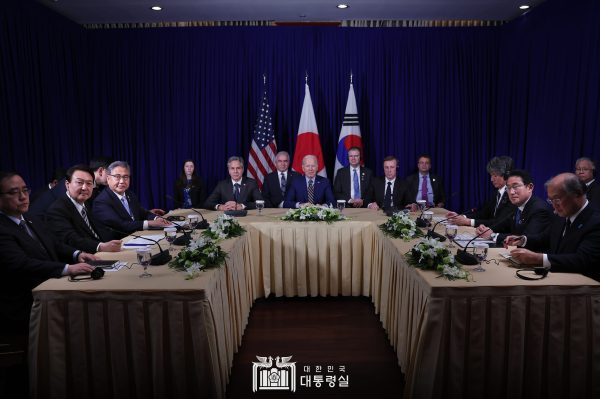
North Korea launched a short-range ballistic missile toward the waters off its east coast, the South Korean Joint Chiefs of Staff (JCS) said on Thursday.
The missile flew about 240 km with an altitude of 47 km. It was launched from the Wonsan area of Gangwon Province around 10:48 a.m. KST. This missile test came eight days after North Korea’s last missile firing, which was another SRBM launched toward its east coast.
Thursday’s missile test also came hours after Korea Central News Agency (KCNA), North Korea’s main state-controlled media, published a statement from Choe Son Hui, the North’s foreign minister.
In her first statement as foreign minister, Choe denounced the South Korea-U.S.-Japan trilateral summit that was held on the sidelines of the ASEAN Summit in Phnom Penh, Cambodia, on Sunday.
“I clarify a serious warning stand on the nonsensical remarks of the U.S., Japan and south Korea made at the tripartite summit a few days ago, about the ‘bolstered offer of extended deterrence’ and ‘strong and resolute counteraction’, asserting the DPRK’s legitimate and just military counteractions as ‘provocation’, even though such measures were incited by their own war drills for aggression,’” Choe said in her statement. (DPRK is an acronym of the North’s official name: Democratic People’s Republic of Korea.)
The leaders of the three countries – South Korea, the United States, and Japan – met on Sunday to reaffirm their joint commitment toward North Korea’s spate of missile launches. Since South Korean President Yoon Suk-yeol took office in May, the United States and its allies in the region have strengthened security cooperation to cope with the North’s missile threats appropriately. In the latest summit, the three leaders agreed to share “real-time missile warning data” to detect the North’s missile launches effectively.
As North Korea’s so-called adversaries are uniting over the North’s missile threats, Pyongyang warned of the results of this coalition.
“The recent tripartite talks will inevitably bring the situation on the Korean peninsula to such an unpredictable pass,” Choe said.
In the wake of Vigilant Storm, the largest-ever joint military air exercise between South Korea and the United States, North Korea launched dozens of missiles and hundreds of artillery shells as a response. After the drill ended, Pyongyang publicly released photos of its missile tests and claimed that the unprecedented missile launches from November 2 to November 5 were carried out as “corresponding military operations.”
During those operations, North Korea launched multiple ballistic missiles, including its Hwasong-17 intercontinental ballistic missile (ICBM) and other advanced short-range ballistic missiles. One of the SRBMs flew toward South Korea’s Ulleung County and landed across the Northern Limit Line – the de facto maritime border between the two Koreas – something that had not happened since the two Koreas divided. Seoul strongly condemned the North’s relatively direct threat to South Korean territory and vowed to respond decisively against the North’s missile threats.
Overall, North Korea deployed more than 180 military aircraft and fired advanced ballistic missiles, including tactical ballistic missiles, and air-to-surface guided missiles during the Vigilant Storm exercise. Pyongyang claimed that the “planned purposes” were successfully achieved through the corresponding military operations.
As the North scaled up its military activities amid the extensive South Korea-U.S. joint military drills, Washington reiterated its full commitment to defend Seoul and Tokyo under the name of extended deterrence. In her statement on Thursday, Choe said that “the U.S. will realize that it has now taken a gamble for which it will certainly regret.”
“The tighter the U.S. holds on to the ‘bolstered offer of extended deterrence to its allies and the more they intensify provocative and bluffing military activities on the Korean peninsula and in the region, the fiercer the DPRK’s military counteraction will be, in direct proportion to it, which will pose a more serious, realistic and inevitable threat to the U.S. and its vassal forces,” Choe said.
Following South Korea-US-Japan Trilateral Summit, North Korea Launches an SRBM
Source: Frappler

0 Comments